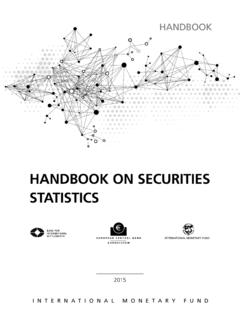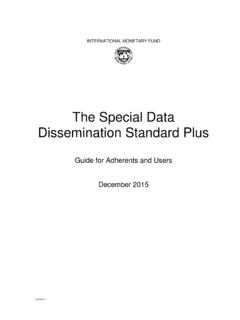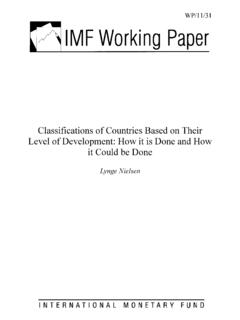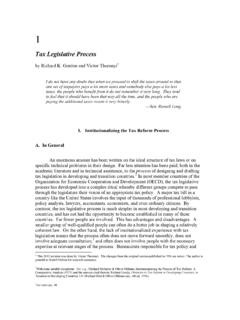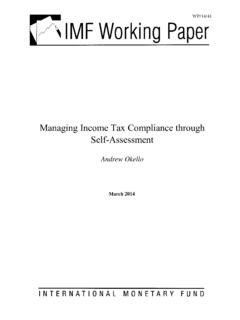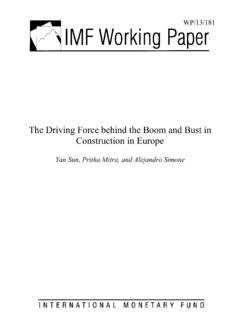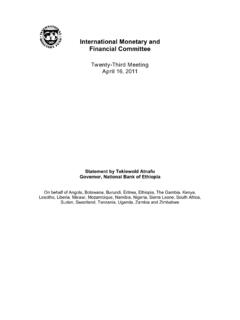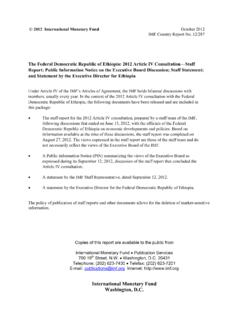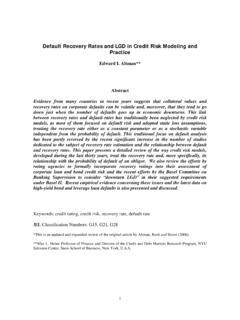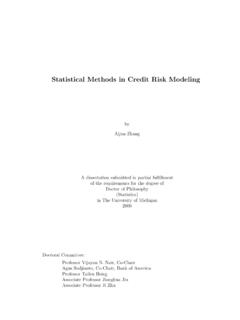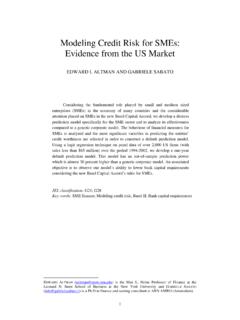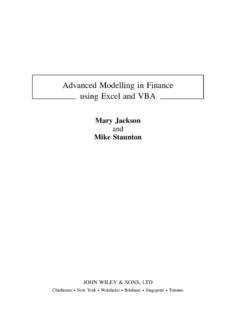Transcription of Modeling Banking, Sovereign, and Macro Risk in a …
1 WP/13/218 Modeling banking , sovereign , and Macro Risk in a CCA Global VAR Dale Gray, Marco Gross, Joan Paredes, and Matthias Sydow 2013 International Monetary Fund WP/13/218 IMF Working Paper Monetary and Capital Markets Department Modeling banking , sovereign , and Macro Risk in a CCA Global VAR Prepared by Dale Gray (IMF), Marco Gross (ECB), Joan Paredes (ECB), andMatthias Sydow (ECB) Authorized for distribution by Dimitri G. Demekas October 2013 Abstract The purpose of this paper is to develop a model framework for the analysis of interactions between banking sector risk, sovereign risk, corporate sector risk, real economic activity, and credit growth for 15 European countries and the United States. It is an integrated macroeconomic systemic risk model framework that draws on the advantages of forward-looking contingent claims analysis (CCA) risk indicators for the banking systems in each country, forward-looking CCA risk indicators for sovereigns, and a GVAR model to combine the banking , the sovereign , and the Macro sphere.
2 The CCA indicators capture the nonlinearity of changes in bank assets, equity capital, credit spreads, and default probabilities. They capture the expected losses, spreads and default probability for sovereigns. Key to the framework is that sovereign credit spreads, banking system credit risk , corporate sector credit risk , economic growth, and credit variables are combined in a fully endogenous setting. Upon estimation and calibration of the global model, we simulate various negative and positive shock scenarios, particularly to bank and sovereign risk. The goal is to use this framework to analyze the impact and spillover of shocks and to help identify policies that would mitigate banking system, sovereign credit risk and recession risk policies including bank capital increases, purchase of sovereign debt, and guarantees.
3 JEL Classification Numbers: C51, G01, G13, G21, H63 Keywords: contingent claims analysis (CCA), global vector autoregression (GVAR). Authors E-Mail Addresses: and This Working Paper should not be reported as representing the views of the IMF. The views expressed in this Working Paper are those of the author(s) and do not necessarily represent those of the IMF or IMF policy. Working Papers describe research in progress by the author(s) and are published to elicit comments and to further debate. 1 CONTENTS PAGE I. Introduction and Overview of CCA-GVAR Framework ..3 A. Overview ..3 B. Motivation and Relationship to the Literature ..5 II. Contingent Claims Analysis for Banks, banking Systems, corporate Sector andSovereigns ..6 A. Expected Loss Ratios for Banks and Non-Financial B.
4 Aggregating Expected Loss Ratios for banking Systems and the Non-Financial corporate Sector ..11 C. sovereign CCA Expected Loss Ratio ..12 III. GVAR Model ..13A. Local B. Weight Matrices ..13 C. Global Solution of the Model ..14 IV. Macro and CCA Data Inputs ..16V. Shock Scenario Analysis ..17 A. Shock Scenario One Adverse Shock to Sovereigns in Italy and Spain ..19 B. Shock Scenario Two Adverse Shock to banking Systems in Italy and Spain ..20 C. Shock Scenario Three Positive Shock to Sovereigns in Italy and Spain ..21 D. Shock Scenario Four Positive Shock to banking Systems in Italy and Spain ..22 VI. Further Extensions and Applications ..23 VII. Conclusions ..25 Appendices I. Contingent Claims Analysis ..28 A. Contingent Claims Analysis: Merton Model.
5 28 B. Moody s Model Overview ..29 II. Weight Matrices ..35 III. Input Data for the CCA-GVAR Model ..37IV. Scenario Profiles on Impact at T=1 ..45V. Dynamic Scenario Responses ..49 VI. Maximum Cumulative Impulse Responses Along Two-Year Horizon ..53 VII. Significance of Scenario Responses ..57 References ..58 Tables 1. Shock Scenarios ..182. Risk Mitigation Policies ..24 2 Figures 1. CCA-GVAR Model Framework ..4 2. Relationships between CCA Capital Ratio, EDF, FVCDS and EL for a Typical Bank ..9 3. Comparison of Ratings, Spreads and 4. Italy: sovereign , banking System, and corporate Sector EL, Real GDP Growth, and Credit Growth ..17 5. Shock Scenario One sovereign Versus Banks Maximum Cumulative Fair-Value Spread Responses ..20 6. Shock Scenario Two sovereign Versus Banks Maximum Cumulative Fair-Value Spread Responses.
6 21 7. Shock Scenario Three sovereign Versus Banks Minimum Cumulative Fair-Value Spread 8. Shock Scenario Four sovereign Versus Banks Minimum Cumulative Fair-Value Spread Responses ..23 9. Example Bank FVCDS, and Markit CDS (bps) ..31 10. Observed CDS Versus FVCDS Showing Spillover from sovereign ..32 11. Spillovers from the sovereign to the Banks and Banks to sovereign ..33 Box 1. Relationships between CCA Capital Ratio, EDF, FVCDS and Expected Loss Ratio for a Typical Bank ..9 3 I. INTRODUCTION AND OVERVIEW OF CCA-GVAR FRAMEWORK A. Overview The goal of this paper is to develop a framework for the analysis of interactions between banking sector risk, sovereign risk, corporate sector risk, growth, and credit for a large sample of banks and countries.
7 Contingent Claims Analysis (CCA) serves to construct risk indicators for banks, respectively for banking systems, sovereigns, and corporate sectors, which we combine with real GDP growth and credit growth in a global model, comprising 15 EU countries and the United States. CCA indicators capture the nonlinearity of changes in bank assets, equity capital, bank credit spreads, and default probabilities that are derived from forward-looking equity market information in conjunction with balance sheet data. It captures the expected losses, spreads and default probability for sovereigns. A Global Vector Autoregressive (GVAR) model approach serves to combine sovereign credit risk , banking system credit risk , GDP growth, and credit growth in a way to allow all variables to interact fully endogenously.
8 The goal is to use that framework to help identify policies that mitigate banking system, sovereign credit risk and recession risk policies that include bank liquidity injections, bank capital increases, purchase of sovereign debt, guarantees of bank senior debt by sovereigns, guarantees of sovereigns by other public bodies, etc. The first section of the paper will present an outline of Contingent Claims Analysis and how the key risk indicators for banks, banking systems, the corporate sector and sovereigns are estimated. A view into how the risk indicators evolve along with real activity shall help develop a first understanding of how sovereign /bank risks relate to business cycle dynamics. The GVAR model framework will then be presented, which is set up for 16 countries, 16 banking sectors which themselves are comprised of 53 individual banks (41 EU banks plus 12 banks).
9 The five-variable version of the model includes banking system CCA risk indicators, sovereign risk indicators, corporate sector risk indicators, economic growth and credit to the private sector. The use of the GVAR model approach to combine these indicators can be motivated along many lines: cross-border linkages with regard to real activity (primarily via the trade channel) have been the rationale underlying most of the existing empirical GVAR literature as of yet. Regarding domestic credit, cross-border linkages matter to the extent that swings in credit supply from internationally active banks from abroad would spill over to other countries to which they have exposure. As to the linkages between sovereign and banking system risk, in particular, we will in later sections of the paper elaborate further on the rationale for cross-sector/cross-country linkages.
10 Figure 1 presents a schematic overview of the model framework, including the CCA components that serve as input to the GVAR and then the various sub-modules that receive as input the simulated scenario responses from the GVAR model. 4 Figure 1. CCA-GVAR Model Framework Scenario Responses GDP growth IRs Credit IRs banking system IRs corporate sector IRs sovereign IRs EU and Euro Zone Aggregate banking and sovereign debt expected losses Aggregate bank capital impact sovereign Module sovereign output results: - Expected Losses - Credit Spreads - Other CCA bank by bank risk indicators (53) CCA sovereign credit risk indicators (16) GDP data (16 series) Credit data (16) Other Scenario Simulation GVAR Model (16 local country models) banking Module banking system responses (ELs and spreads) Bank by bank output results.

